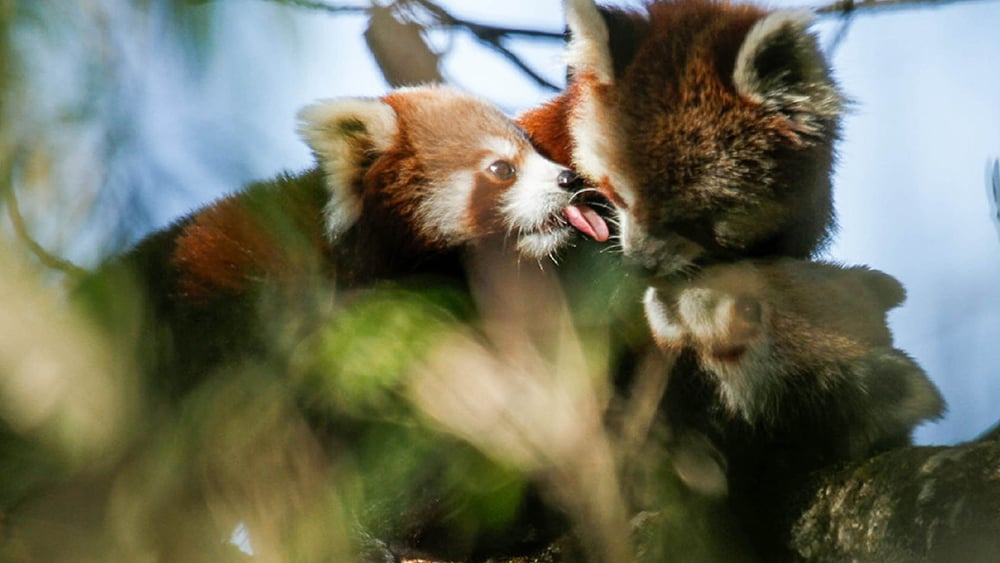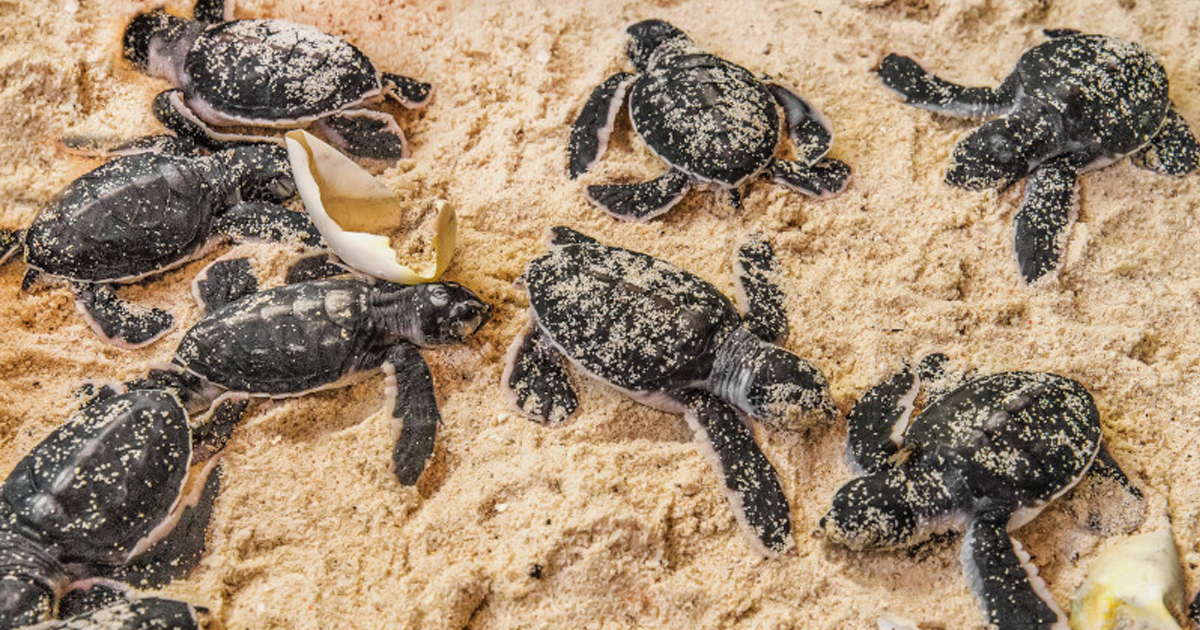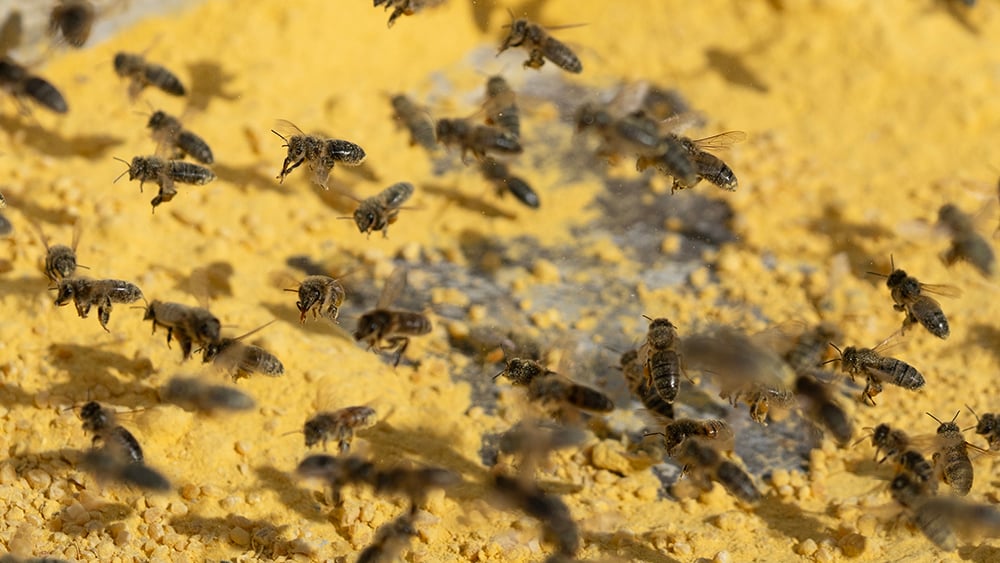20 Species We’re Safeguarding Worldwide
Our planet is experiencing a biodiversity crisis, with one in five species facing extinction. Greater Good Charities is committed to protecting these critical species and biodiversity around the world—keeping our planet safe for generations to come.
Thanks to your generosity, we are making progress. Here are 20 species we’ve helped protect through your support.

Lemurs
Greater Good Charities is partnering with the North Florida Wildlife Center, which is currently home to two species of lemur: the endangered ring-tailed lemur and the critically endangered black-and-white ruffed lemur. These beautiful animals are facing dire threats from habitat destruction, deforestation, illegal pet trade, and poaching. Farmers are cutting down forests for cropland and charcoal production, while climate change is driving severe droughts in Madagascar, disrupting ecosystems and food sources for these endangered animals.

Last March, the North Florida Wildlife Center celebrated the birth of an endangered ring-tailed lemur pup, born to Felana and Maharo, two lemurs rescued from the illegal pet trade. Now these endangered animals are thriving in a sanctuary designed to protect endangered species. We are currently funding the construction of an entirely new lemur habitat for the critically endangered black-and-white ruffed lemur. Once this habitat is completed, these lemurs will live safely in a habitat more conducive to their natural behaviors and breeding.
Our partners are also work tirelessly to promote their conservation and our habitat restoration efforts in Madagascar.
Pangolin
Pangolin are the most trafficked mammal with populations rapidly declining in both Asia and Africa because poachers illegally trap, traffic, and kill them for their scales. When threatened, pangolins roll up into a tight ball to protect themselves, making them an easy target for poachers.
Greater Good Charities is working with Wildlife at Risk, a top Vietnamese conservation organization, to help save pangolins. Together, we are protecting this incredible species through upgraded and new shelters, rehabilitation and breeding programs, as well as, monitoring and studying their behaviors to learn new ways to keep them safe.
Small Clawed Otter
The small-clawed otter species has decreased by more than 30% worldwide. This tiny mammal is dying due to starvation, the exotic pet trade, and habitat loss.
We are working with partners in Vietnam to help several otters rescued from illegal trafficking. Small-clawed otters need to eat freshwater fish daily, and the cost to feed and shelter these rescued otters is expensive. Thanks to you, we've been able to help feed and protect these adorable creatures.

Foxes
Foxes are crucial for biodiversity, but due to habitat loss and poaching, populations have suffered.
These magnificent creatures play an important role in their ecosystem. As predators of various species, they help control their population as well as play an important role in seed dispersal.

Due to mining, agriculture, and poaching, these foxes are under attack. That's why we continue to do everything possible to protect these foxes by conserving 150,000 acres of land in Argentina, as well as partnering with multiple animal rescue organizations to provide shelter and rehabilitation to rescued foxes, including foxes rescued from the fur trade.
The Giant Anteater
The giant anteater, found in Central and South America, is classified as vulnerable, with fewer than 5,000 individuals remaining in the wild. These fascinating creatures play a vital role in ecosystem balance by feeding on ants and termites, but they face threats like habitat loss, road collisions, and hunting.

Much about giant anteaters remains a mystery, and understanding their population dynamics, growth rates, and health is crucial for their protection. Greater Good Charities is partnering with researchers in Brazil to study this incredible species and help ensure their survival.
Protecting animals like the giant anteater is about more than saving a single species—it’s about preserving entire ecosystems for generations to come. Your donations fund critical research and conservation efforts to protect these animals and their habitats.
Jaguars
Brazil's Pantanal, the world's largest tropical wetland area, experienced devastating wildfires last year that scorched an area the size of New Jersey—over 3 million acres. The fires spread quickly and wildlife, including threatened species such as jaguars, were perishing in the fires.
Itapira was one of those jaguars. She was spotted lying motionless in a drainage pipe. Concerned about her wellbeing, a rescue team placed water nearby, but she didn’t move. After waiting a day without any sign of improvement, the decision was made to sedate her and perform a rescue. She had burns on all four paws, was severely dehydrated, and was too weak to survive on her own.

We were proud to partner with teams on the ground to provide lifesaving medical care to jaguars like Itapira who are suffering severe burns and injuries and provide aid through the rescue and recovery of critical species like the Jaguar.
Red Wolves
There are currently less than 20 individual red wolves living in the wild. Red wolves are dying along at an alarming rate due to vehicle strikes on US Highway 64 in eastern North Carolina. In the last 14 months alone, 5 endangered red wolves have been killed by vehicle strikes.
Chance is one of the red wolves that lived near the highway. Her breeding partner was killed by a vehicle strike just six weeks after their pups arrived.

Tragically, after this accident, all five of Chance’s pups were reported to have died. After the death of her partner, Chance was likely unable to feed and care for her pups by herself as a first-time, single mother. A wildlife crossing may have saved Chance’s breeding partner, and it’s not too late to save the remaining red wolves. In partnership with the Center for Biological Diversity, we’re helping to build a wildlife crossing across US 64 to ensure a future for this rare and remarkable species.
Guanaco
The Guanaco lives in family groups of 5-13 members and is known for its thick wool coats. When living in healthy habitats, they can live up to 25 years. Sadly, due to habitat loss, human intervention, and droughts, the guanaco population has suffered. Each winter, they migrate hundreds of kilometers to lower altitudes to feed. However, the areas for them to migrate are dwindling. In order to help protect this beautiful species, we are protecting the guanaco by conserving 150,000 acres of land in Argentina. This serves as the main winter range for migrating guanacos.

Bees
Greater Good Charities is dedicated to saving the Bees as they are essential to our planet and our future. We have multiple initiatives to protect and rescue bees after disaster—whether it's feeding bees after Hurricane Helene, providing essential aid to beekeepers in Ukraine, or working with Borderlands Restoration Network to restore the Bee’s habitat- specifically by planting wildflowers in Southern Arizona to attract pollinators. We are committed to protecting this vital part of our food chain.
Elephants
Over the past three decades, Asian Elephant populations have declined by at least 50%. Many Asian elephants are forced into captivity, poached for their tusks, and are rapidly losing their habitat due to deforestation.
Thanks to your support, we've been working with partners to secure a safe habitat for elephants, reduce human-elephant conflicts, and half the ivory trade

There are only about 2,400-2,800 Sumatran elephants left in the world due to increasing rates of poaching and deforestation (World Wildlife Fund) Because of generous donors like you, Greater Good Charities has granted funding to partners for the protection of Sumatran elephants, focusing on habitat loss, wildlife rescue and care, human-wildlife conflict, and illegal wildlife trade.
Rock Horned Lizard
An important part of conserving and protecting our environment is the study and research of key biodiversity hotspots and species facing imminent threat and loss. We do this by sending teams of uniquely qualified scientists to observe and collect scientific data or key native plants and animals around the world. On each expedition, scientists will observe about 1,000 animals and plants to protect the biodiversity hotspot.

Our team of herpetologists, those who study amphibians and reptiles, visited one of the Madrean Sky Islands to learn more about the Rock Horned Lizard, only found in Sonora. The data collected from this, and every expedition is entered into a public database to use this information for current and future research, environmental education, and habitat protection.
Manatees
Manatees face a declining population due to loss of habitat, food sources, and encounters with humans, typically boating-related accidents. A variety of efforts and legislation have sought to address the shrinking manatee population, including listing them as threatened and prompting multiple efforts to preserve their habitat and protect them from danger. To protect these majestic creatures, we have been working with partners to help feed, protect vital manatee habitats, and support manatee sanctuaries.
.png?width=533&height=533&name=VS-Photograph_20240827_BC-DRD_CMA_Manatees_Zamboni_and_Yeti_001_%C2%A9ClearwaterMarineAquarium%20(1).png)
Platypus
Drought and bushfires in Australia have resulted in the loss of over one billion native animals and put the survival of species like the platypus in immediate peril. Their habitat is shrinking, their food sources are becoming more scarce, and they are predated upon by foxes and feral cats. Current climate predictions only exacerbate the problem. Platypus populations are expected to decline by a further 50% by 2050, following current trends.

But hope for these odd little mammals is not lost. Greater Good Charities partnered with Taronga Zoo to build and operate rescue and research facilities to house up to 65 platypuses. The Taronga Platypus Centre for Rescue, Rehabilitation, Research, and Reproduction is a high-tech facility equipped with technology that enables researchers to study, record, and share previously unknown information about this mysterious species while providing the best health and welfare for the platypus. As well as rescuing and providing refuge in crisis times, they collected wild founders from six different river systems to study and establish a breeding program which maintains genetic and behavioral diversity, with the ultimate goal being release back to the wild.
Bats
Bats are incredibly important pollinators and vital to our biodiversity. More than 1,300 bat species across the globe pollinate and fertilize crops and consume bast amounts of harmful insects. Sadly, according to the International Union for the Conservation of Nature, there are over 200 bat species listed as endangered, threatened, or vulnerable. Many bats are also needlessly injured or killed in conflicts with humans.

In addition to studying bats extensively through our scientific expeditions and working with partners to feed and shelter these important pollinators, we also provided a grant to Borderland Restoration Network to support their restoration efforts. BRN works to balance out the destruction of agaves, which feed two species of at-risk bats, which allows them to spread seeds that maintain the fragile biodiversity of the area.
Tigers
Known for its stunning stripes, the tiger is a symbol of natural strength, poise, and wonder, but the species is in danger. In fact, over the last 100 years, we’ve lost over 90% of the world’s tiger population, leaving us with less than 4,000 wild tigers around the world today. Some scientists predict that they could all be extinct in the wild within the next decade.

This rapid decline in tiger population is caused by poaching, habitat fragmentation, and habitat loss. Additionally, despite being a master of the wild, this big cat cannot compete with human populations for land and food. Greater Good Charities has been working with the best non-profits to combat poaching, and habitat loss, as well as, working to build sanctuaries and shelters for rescued tigers, including helping to build a 50-acre tiger habitat that are now home to tigers that were rescued from Joe Exotic.
Giant Pandas
Panda cubs are the smallest newborns in the bear species, weighing as little as 4 to 8 ounces and are about 6 to 8 inches long. They are born pink, with almost no hair, and blind. They are very fragile and defenseless and they often come in pairs.

Some giant panda mothers do not know how to properly care for their firstborn cubs or are not able to produce enough milk to provide their cubs with nutrients. Greater Good Charities was able to provide a significant grant to save the lives of giant panda cubs in China, thanks to you. This grant provided special formula, to feed baby pandas until they are old enough to live off bamboo.
Red Pandas
Though they share a name and diet, pandas and red pandas are not closely related. Red pandas are much smaller than giant pandas and are the only living member of their taxonomic family—the Ailuridae family. Red pandas are endangered due to several threats, but habitat loss is the primary threat to red pandas. Rapid human population growth, climate change, and unsustainable living practices are causing the degradation and fragmentation of red panda habitat.

Greater Good Charities provided a grant to the Red Panda Network's First Panda Challenge, helping to restore red panda habitat by planting trees that have been identified as red panda food and shelter. Restoring it would create a critical corridor for red pandas and other endangered wildlife in the area.
In addition, RPN Forest Guardians will conduct ongoing monitoring of red panda populations and habitat with camera traps and data from pre-restoration will be compared to post-restoration which will allow scientists to measure the impact of the project.
African Rhino
Rhino numbers in the wild continue to drop and very few rhinos survive outside national parks and reserves due to poaching and habitat loss. Of the five living rhino species, three are classified as critically endangered on the IUCN Red List of Threatened Species, the black, Sumatran, and Javan rhinos.
Greater Good Charities partnered with the International Rhino Foundation (IRF) to raise funds for emergency support to help protect the African Rhino. IRF used those funds to help pay for on-the-ground expenses to maintain the protection and monitoring programs needed to ensure rhinos’ survival.

The Sumatran Rhino needs our protection, as they are one of only two rhino species large enough to reproduce and thrive in the wild. The Sumatran Rhino also relies heavily on a large rainforest to roam and graze. Without supporters like you, who have allowed Greater Good Charities to grant our partners at International Rhino Foundation the funds needed to help rebuild their rainforest, they would not survive.
Snow Leopard
There are only 3,900-6,400 snow leopards left in the world due to habitat loss, poaching, and retaliatory killing when they turn to livestock for prey. About one snow leopard is illegally poached every day.

That's why Greater Good Charities teamed up with Snow Leopard Trust to protect livestock in the hope of securing the future of snow leopards. With your donations, Greater Good Charities partnered with Snow Leopard Trust for a livestock insurance program in Mongolia to provide direct compensation to herder families who lose valuable livestock to snow leopard predation. The program works in a region of South Gobi, called Tost, where roughly 85 semi-nomadic families share space with snow leopards.
Vaquita & Sea Lion
The Sea of Cortez is considered one of the most biodiverse places on the planet but, unfortunately, is home to many endangered species as well. Sea Lions and Vaquitas feed on fish species commonly targeted by fishermen, leading to a sharp increase in "entanglement events" such as getting caught up in fishing gear. That's why we partnered with CEDO (International Center for the Study of Deserts) to protect Vaquitas and Sea Lions through their “Save Our Sea of Cortez Treasures: Migratory Birds, Vaquita and Sea Lions Harmed by Fishing'' project.

Additionally, due to toxic and harmful algae blooms, these vulnerable creatures often suffer illness and even brain damage. We've partnered with multiple organizations that are working to rescue and rehabilitate sea lions, vaquitas, and other animals to then be released back to their natural habitats.
You Can Help Wildlife
These are just 20 of the many species protected, rescued, and supported thanks to you. Together, we can continue this urgent work—protecting ecosystems, advancing research, and keeping species from extinction.
Donate today to protect wildlife around the world.


